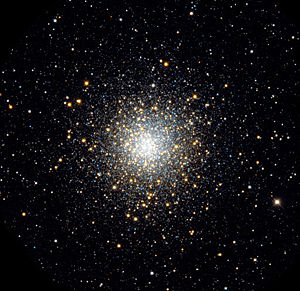Messier 10
|
Globular cluster Messier 10 |
|
|---|---|

|
|
|
The globular cluster Messier 10, Till Credner and Sven Kohlen, Hoher List Observatory |
|
| AladinLite | |
| Constellation | Snake bearer |
|
Position equinox : J2000.0 , epoch : J2000.0 |
|
| Right ascension | 16 h 57 m 09 s |
| declination | −04 ° 05 ′ 58 ″ |
| Appearance | |
| Concentration class | VII |
| Brightness (visual) | 6.6 likes |
| Angular expansion | 20.0 ' |
|
Color excess E (BV) (redness) |
0.28 |
| Physical data | |
| Redshift | (252 ± 3) · 10 −6 |
| Radial velocity | (+75.4 ± 1.0) km / s |
| distance | 14.3 kLj (4.4 kpc ) |
| Absolute brightness | −7.35 mag |
| diameter | 83 ly |
| Concentration lg (r t / r c ) | 1.4 |
| Metallicity [Fe / H] | −1.52 |
| history | |
| discovery | Charles Messier |
| Discovery date | May 29, 1764 |
| Catalog names | |
| M 10 • NGC 6254 • C 1654-040 • GCl 49 • | |
Messier 10 or M10 (also known as NGC 6254 ) is a 6.6 mag bright globular cluster with a diameter of 19-20 'in the constellation of the Serpent Bearer (Ophiuchus). Of the 5 globular clusters in the constellation (M9, 10, 12, 14 and 107), it is the second brightest.
It was discovered by the French astronomer Charles Messier on May 29, 1764 (one day before the neighboring M12) and, with about 200,000 solar masses, is the average of the globular clusters. At 25,000 light years (according to Hipparcos) it would be relatively large at 140 LJ. It is dominated by old yellow stars, but only 4 variables among them. Just a tiny nebula in binoculars, it only shows its structure from a telescope opening of around 15 cm. It is a little more compact than Messier 12, which is 3 ° northwest .
Messier noted it as a small but beautiful "nebula without a star". It was not until 20 years later that Wilhelm Herschel characterized it as a "wonderful cluster of very densely packed stars" with no trace of a nebula and compared it to Messier 51 . His son John Herschel determines stars 10 to 15 magnitude (actually from 12 mag), which culminate in a luminous center without a core. In his giant telescope, Lord Rosse recognized a dark point on the upper edge for the first time, and that the upper sixth of the heap is much fainter than the majority of it is a dark dividing line on the southern edge. Curtis describes it photographically around 1918 with 8 'diameter and a light central part of 2'.
Already recognizable as a nebula in the 8 × 30 binoculars , at 10 × 50 you can see a small, blurred disc that appears somewhat elongated and 10 'in size in the 10 cm amateur telescope. The 25 brightest single stars up to ~ 15 mag can only be seen in the six to eight-inch model . Even larger openings show a compact core of 4 'and a halo of 15' in which some groups of stars are arranged in a chain or spiral.
A hot blue giant of 13th magnitude protrudes beneath the stars. According to R. Stoyan, it is in the preliminary stage of a planetary nebula , but not yet hot enough to stimulate the expanding gas envelope.

Literature and web links
- Ronald Stoyan : Atlas of the Messier Objects - The Highlights of the Deep Sky , p. 92-93. Oculum-Verlag, Erlangen 2006
- Bernd Koch, Stefan Korth: The Messier Objects - The 110 classic goals for sky observers . Pp. 28/29, Kosmos-Verlag, Stuttgart 2010
- M10 at SEDS
- Spektrum.de : Amateur recordings [1]

